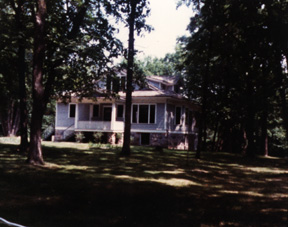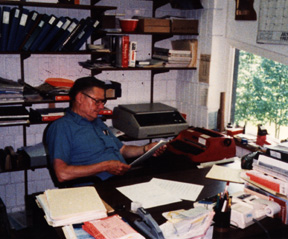Biographical Notes reCharles A. (Chuck) StonePage 1 of 5 Pages, of Chapter 13,THE LINDBERGH LEGACY |
|||||||
| The Lindbergh Historic Home and Interpretive Center is located on the west side of the Mississippi River at the edge of the Little Falls city limits. It is connected to Lindbergh State Park, located across the road. While the Historic Home and Interpretive Center, encompassing around seven acres of wooded land, is controlled by the State Historical Society, the Park, itself, is under the management of the MN Department of Natural Resources. Both entities operated at different levels of staffing and public service, depending on the season of the year. Under normal conditions, the Historic Site was staffed for public visitation from May through October with the assistance of seasonal employees under the supervision of a year-round manger. From November through April, the Site Manager looked after the safety and security of the property, worked in cooperation with the home office on program and exhibit upgrading issues, and served as a year-round link with the Minnesota Historical Society and the general public. In actual practice, during my tenure, the Site was open for visitation and guided tours of the historic home, seven days a week from 10:00 to 5:00. The September and October schedule varied, depending upon the state of the U.S. and State of MN economy and funds available for Historic Sites operation. Initially, into the early 1980s, the site was staffed and open on a daily basis in September and October. As funds became more limited, we moved to an open on weekends only basis during the fall season. As the decade progressed, there was a time when I was ordered to close the doors after Labor Day, due to lack of funding. With a great many senior citizens, the fall season was an ideal time to be on the move. School children were in school and senior citizens had less competition for lodgings and other services. During these times, though officially closed, I found them pulling on the front door of the Lindbergh Interpretive Center and I could not bear to say “we are closed”. |
|||||||
 |
|||||||
|
Charles A. Lindbergh, Jr. Little Falls, Minnesota |
|||||||
 |
|||||||
|
in the mid-1980s. |
|||||||
 |
|||||||
|
|
|||||||
| During those periodic funding droughts, minus most or all of my support staff, I found myself hosting visitors in the Interpretive Center, alone, almost seven days a week. This was not a problem for me, as I was loving every minute of it. Our visitors were almost invariably filled with nostalgic memories of the late 1920’s and early 1930’s, had vivid memories relating to the Lindbergh History, and wanted to remind themselves of where their life paths crossed those of the Lindbergh Family. When I first stepped in the door of the Interpretive Center, there was no parting manager to check me out on what was where and how things worked. The snow was drifting through the parking lot and clogged the walking path leading down to the Interpretive Center, buried in the side of a steep hill, located on the banks of the Mississippi River. I found a snow blower, got it running and proceeded to blow out the path. In short order the blower blew a rod right through the crankcase of the machine and I began to learn how to process emergency purchase orders through the MHS and State of MN funds management system. The relative quiet of the late winter season gave me time to become familiar with the various elements of my job and the methods I would use to work with my supervisors at the MHS Headquarters. The month of April arrived all too soon and my recent efforts to locate, and learn from past seasonal employees and benefit from their counsel and advice began to pay off. I went through the usual advertising, interviewing and hiring of the best qualified applicants available and we were soon ready for the May First opening. For much of my time as Site Manager, visitors could come and go without buying a ticket. It was such a pleasure to offer this remarkable historic site facility, with its most remarkable history, as a gift to the general public. We did have a museum store where they could invest their money, if they so chose. Visitation at the Center involved seeing a Lindbergh history film in the theater and then touring self-guided exhibits that began in the lobby, leading up a couple of ramps to a complex of exhibit halls on the second floor. This was followed by our invitation for guests to walk over to the Historic Home for a guided tour. Having rehired as many experienced seasonal staff members as possible, we were off to an effective, harmonious and meaningful operation from the start. I was filling out my knowledge of Lindbergh history as rapidly as I could, while learning to take care of administrative tasks, assuring the safety of buildings, property and visitors. It was a joy, and in all truth, if I had just won the lottery, I would have done it for free. This wasn’t quite the case though. My wife and I have never invested in lottery tickets. As the summer wore on, and I had an opportunity to become familiar with the grounds, as well as the buildings, I realized that it would be great to have a Nature Walk that would provide our guests an alternative way to move from the Center to the Home. There was a lot of work involved in a project of that scope, work that I was not staffed to do. By this time, I had been authorized a contract maintenance worker who could put in a specific number of hours each month doing a variety of maintenance tasks. Through local Job Service personnel, I learned that they had a variety of young (adult?) men and women who needed work along with various forms of rehabilitation training. As I recall, I accepted responsibility for four of these individuals, all women, to work on our Nature Walk project every week, under the secondary supervision of our maintenance man. As the summer progressed a trail was cut that took a visitor from the Center, along the banks of the Mississippi, below the Historic Home, then providing a choice of a short loop to the House for a tour, or a longer loop down to the Weyerhaeuser Museum, next door, and then looping back to the House. It was wonderful to see how this working group developed a bond of mutual interest, friendship and purpose. The trail was covered with bark chips, donated by the local paper mill debarking plant, and was soon finished. As the years passed, we began a new tradition of hosting a special Mother’s Day Nature Walk along the river with one of our guides lecturing along the way. It is in use, even today. As I moved through the Interpretive Center, I was frustrated by the amount of blank wall space that seemed to be crying out for something to share with the passing public. To deal with this on an interim basis, over time, I conducted a number of art shows where area artists could show off their works. The art openings were designed to be public social events with food and refreshments available. These went over very well and the local public, that had gradually become apathetic regarding this historic site on their doorstep, found themselves with renewed interest. In the Spring Season of 1981, as I was making preparations to attend the May 21 Lindbergh Fund events in New York, the upcoming Memorial Day and memories of my Uncle Herb caused me to write and submit for public use “A REMINISCENT MEMORIAL DAY LETTER TO UNCLE HERB. If this subject is of interest to you, I have reproduced this letter for your review in these web pages. Click here to access this Memorial Day Letter and, at the end, you will find a quick return to this page. Otherwise, feel free to move on to Page 2 of Chapter 13. |
|||||||
|
End of Page 1 of 5 Pages, Chapter 13 — Go to Page 2 Click below to select a destination Go to Page 1 — 2 — 3 — 4 — 5, this Chapter Chapters 1 — 2 — 3 — 4 — 5 — 6 — 7 — 8 — 9 — 10 |
|||||||